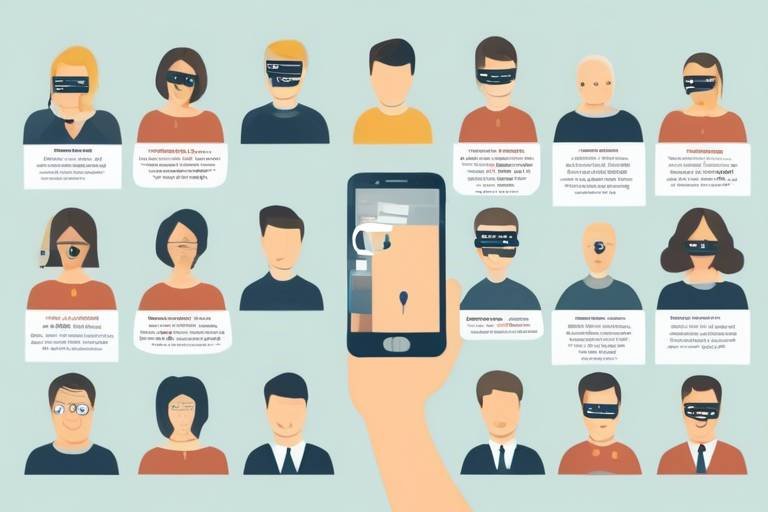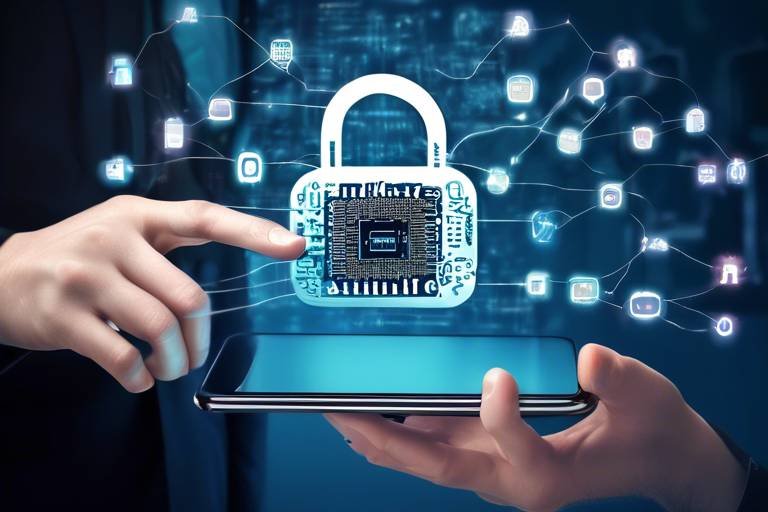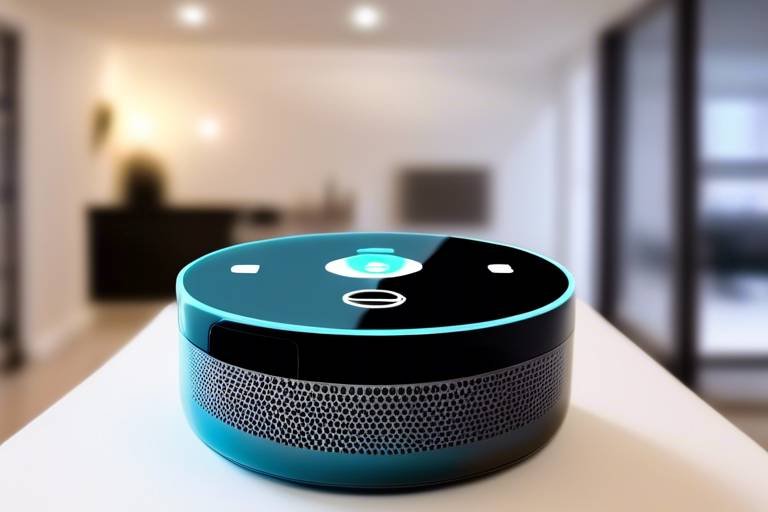Privacy Issues with Internet of Things Devices
The rise of the Internet of Things (IoT) has transformed the way we interact with technology, bringing a new level of convenience and connectivity to our daily lives. However, with this increased connectivity comes a myriad of privacy concerns that users often overlook. Imagine waking up to a smart home that knows your routine better than you do—sounds convenient, right? But what happens when that same home is vulnerable to cyber-attacks or unauthorized surveillance? The reality is that while IoT devices promise a smarter, more efficient lifestyle, they also open the door to a range of privacy issues that can compromise our personal information.
As we dive deeper into the world of IoT, it's essential to understand that these devices are not just passive tools; they are active participants in a vast network that constantly collects, shares, and processes data. From smart refrigerators that track your grocery habits to wearable fitness trackers that monitor your health metrics, each device contributes to a larger ecosystem of interconnected technology. While this connectivity can enhance our lives, it also raises serious questions about who has access to our data and how it is being used. The implications of this data collection can be profound, affecting everything from our personal privacy to our security.
In this article, we will explore the various privacy concerns associated with IoT devices, from the types of data collected to the potential for breaches and hacks. We'll also take a look at the legal frameworks designed to protect users and what the future may hold for privacy in an increasingly connected world. So, buckle up as we navigate through the intricate landscape of IoT privacy issues—because understanding these risks is the first step towards protecting yourself in this digital age.

Understanding IoT Devices
The Internet of Things (IoT) is not just a buzzword; it's a revolutionary concept that is reshaping our daily lives. Imagine a world where your refrigerator can remind you to buy milk, your thermostat adjusts the temperature automatically based on your preferences, and your fitness tracker provides real-time health insights. This is the essence of IoT devices—they are interconnected gadgets that communicate with each other and with us, creating a seamless flow of information that enhances convenience and efficiency.
At its core, IoT encompasses a vast network of devices equipped with sensors, software, and other technologies that enable them to connect to the internet and exchange data. These devices range from simple household items like smart bulbs and thermostats to more complex systems like smart cities and autonomous vehicles. The interconnected nature of these devices allows for unprecedented levels of automation and control, but it also raises significant privacy concerns.
In a typical IoT ecosystem, devices collect and share a multitude of data types. For instance, smart home devices may track your daily routines, while wearables monitor your health metrics. This constant data exchange contributes to a more personalized experience but also creates vulnerabilities. The more data that is collected, the greater the risk of it being accessed or misused by unauthorized parties. This is where the dual-edged sword of convenience versus privacy comes into play.
As we dive deeper into the world of IoT, it's essential to understand how these devices function within a broader network. Each device acts as a node, communicating with others to create a cohesive system. For example, a smart home may include:
- Smart Speakers: Devices like Amazon Echo or Google Home that respond to voice commands and control other smart devices.
- Smart Appliances: Refrigerators, ovens, and washing machines that can be controlled remotely.
- Wearables: Fitness trackers and smartwatches that monitor health metrics and sync with mobile applications.
This interconnectedness means that a breach in one device could potentially compromise the entire network, leading to significant privacy violations. For instance, if a hacker gains access to a smart camera, they might also access other connected devices within the same network. This scenario underscores the importance of robust security measures and user awareness.
In summary, while IoT devices offer remarkable conveniences and capabilities, they also introduce a host of privacy challenges. As users, it’s crucial to remain vigilant about the data we share and the devices we connect. Understanding the implications of IoT technology is the first step toward safeguarding our personal information in this increasingly connected world.

Common Privacy Risks
The rise of Internet of Things (IoT) devices has brought unparalleled convenience into our lives. However, this convenience comes at a cost, as it opens the door to a myriad of privacy risks that can leave users vulnerable. Imagine living in a house where every appliance is connected to the internet, from your fridge to your thermostat. While you can control everything with a simple voice command, each device is also a potential gateway for hackers and data thieves. So, what are the common privacy risks associated with these smart gadgets?
One of the most pressing concerns is the risk of data breaches. IoT devices often collect vast amounts of personal information, which can be targeted by cybercriminals. For instance, if a hacker gains access to your smart home system, they might not only control your devices but also harvest sensitive data like your daily routines, location, and even your health information. It's like leaving your front door wide open while inviting strangers into your home!
Another significant issue is unauthorized access. Many IoT devices lack robust security measures, making them easy targets for intruders. Consider this: if your smart doorbell can be hacked, it could allow someone to watch your comings and goings without you ever knowing. This unauthorized access can lead to physical break-ins or identity theft, creating a perfect storm for privacy violations.
Moreover, the potential misuse of personal information is a growing concern. Companies often collect data to improve their services, but what happens to that data once it's in their hands? Users may not realize that their information could be sold to third parties or used for targeted advertising without their explicit consent. This can feel like being watched through a one-way mirror, where you have no idea who’s observing you or how they’re using your data.
To further illustrate these risks, let’s break down some common privacy threats associated with IoT devices:
- Insecure Devices: Many IoT devices are shipped with default passwords that users often forget to change, making them easy targets for hackers.
- Data Overload: The sheer volume of data collected can overwhelm users, leading to a lack of awareness about what information is being shared and with whom.
- Weak Encryption: Not all IoT devices employ strong encryption methods, which can leave data vulnerable during transmission.
As we navigate this interconnected world, it's crucial to be aware of these common privacy risks. The convenience of IoT devices should not come at the expense of our personal security. By understanding these threats, we can take proactive steps to safeguard our information and enjoy the benefits of technology without compromising our privacy.

Data Collection Practices
In today’s digital age, the Internet of Things (IoT) devices are revolutionizing how we live, work, and interact with our environment. However, while these devices offer incredible convenience, they also raise significant concerns regarding . From smart home assistants to wearable health trackers, IoT devices are constantly gathering a wealth of information about us. But what exactly are they collecting, and how does this impact our privacy?
First off, it’s essential to understand that IoT devices collect data in various ways. They can track your location, monitor your health metrics, and even analyze your behavioral patterns. For instance, a smart thermostat learns your temperature preferences over time, while a fitness tracker records your daily activity levels. This extensive data collection can be beneficial, but it also opens the door to potential misuse. Imagine your health data being sold to insurance companies without your knowledge—it's a daunting thought, isn’t it?
Moreover, the types of data collected can be categorized into several key areas:
- Personal Identification Information: Names, addresses, and contact details.
- Location Data: GPS coordinates and travel history.
- Health Data: Heart rate, sleep patterns, and exercise routines.
- Behavioral Data: Usage patterns, preferences, and interactions with other devices.
As we delve deeper into these data collection practices, one glaring issue arises: the lack of consent and transparency. Many users are often unaware of the extent to which their data is being collected. The terms and conditions associated with IoT devices are often lengthy and filled with legal jargon that can confuse even the most tech-savvy individuals. This raises a crucial question: are we truly giving informed consent when we click “agree”?
Furthermore, the implications of extensive data collection go beyond mere privacy concerns. With vast amounts of personal information at stake, the potential for data breaches becomes a significant risk. If a hacker gains access to a smart home system, they could potentially control everything from security cameras to smart locks, posing a severe threat to personal safety. The reality is that while IoT devices enhance our lives, they also create a complex web of vulnerabilities that can be exploited.
In conclusion, understanding data collection practices is vital for anyone using IoT devices. As we embrace this technology, we must remain vigilant about our privacy. Are we comfortable with the amount of data being collected? Are the benefits worth the risks? These are questions that every user should consider as they navigate the increasingly connected world of IoT.

Types of Data Collected
When you think about the Internet of Things (IoT), it's almost like stepping into a sci-fi movie where your devices are constantly gathering information about you. But what exactly are these devices collecting? The types of data collected by IoT devices can be quite extensive, ranging from the mundane to the deeply personal. Understanding these categories is crucial, not just for tech enthusiasts but for anyone who uses these devices in their daily lives.
At the heart of the IoT ecosystem lies a treasure trove of data that can be categorized into several key types:
- Location Data: Many IoT devices, such as smart home systems and wearable fitness trackers, continuously track your location. This information can be used for navigation, but it also poses a risk if intercepted by malicious actors.
- Health Metrics: Wearable devices, like smartwatches, collect data related to your health—think heart rate, sleep patterns, and even stress levels. While this information can help you lead a healthier lifestyle, it can also be exploited if it falls into the wrong hands.
- Behavioral Patterns: IoT devices often analyze your habits and routines to optimize their functionality. For example, smart thermostats learn your temperature preferences, while smart speakers may curate your music choices. However, this data can reveal a lot about your daily life and personal preferences, making it a potential target for privacy breaches.
Moreover, the implications of this extensive data collection are profound. It’s not just about what is collected, but how it is used. Companies may use this data to create detailed profiles of users, which can be sold or shared without explicit consent. Imagine a world where your daily habits are laid bare for advertisers, or worse, where sensitive health data could be used against you in an insurance claim.
In addition to the types of data collected, there are also concerns regarding the context of usage. For instance, a smart home device that collects data on when you are home can inadvertently expose your routines to potential burglars. This kind of information can be incredibly valuable to those with malicious intent, making it imperative for users to be aware of the risks associated with their devices.
Ultimately, while IoT devices offer convenience and efficiency, they also come with a hefty price tag in terms of privacy. Users must navigate this complex landscape with caution, ensuring they understand what data is being collected and how it might be used. As we become increasingly reliant on these technologies, the responsibility lies with both manufacturers and users to safeguard personal information and maintain a balanced approach to privacy.
- What types of data do IoT devices commonly collect? IoT devices typically collect location data, health metrics, and behavioral patterns.
- How can I protect my privacy when using IoT devices? Regularly update your device software, review privacy settings, and limit data sharing where possible.
- Are there regulations governing the data collected by IoT devices? Yes, various regulations like GDPR exist to protect user data, but enforcement can vary.

Consent and Transparency Issues
When it comes to Internet of Things (IoT) devices, one of the most pressing concerns is the issue of consent and transparency. Many users often click “agree” to terms and conditions without fully understanding what they are consenting to, and this is where the trouble begins. The fine print can be a minefield, filled with legal jargon that can leave the average consumer scratching their head. What exactly are you agreeing to when you connect your smart thermostat or wearable fitness tracker? Often, it feels like signing a blank check.
Moreover, the transparency surrounding data collection practices is alarmingly low. Users might not be aware of how much data their devices are collecting, how it is being used, or who it is being shared with. For instance, your smart fridge might be tracking not just what you eat, but when you eat it, your shopping habits, and even your dietary preferences. This data can be incredibly valuable, but it raises significant questions about privacy and ownership of personal data.
To put it bluntly, the current landscape often feels like a game where the rules are hidden. Users are left in the dark, and this lack of clarity can lead to feelings of mistrust. Many consumers are unaware that their data might be sold to third parties or used for targeted advertising without their explicit consent. In an age where data is currency, understanding the fine print is more crucial than ever.
Furthermore, regulations around consent are often outdated or insufficient to keep pace with the rapid evolution of IoT technology. While laws like the General Data Protection Regulation (GDPR) have made strides in protecting user rights, many IoT devices still operate in a gray area. The question remains: how can users truly give informed consent when they don’t fully understand what they’re consenting to?
In conclusion, the challenges surrounding consent and transparency in IoT devices are multifaceted and require urgent attention. Users must be empowered with clear and accessible information about their data and how it is being used. As technology continues to advance, it’s essential for manufacturers to prioritize user trust by adopting transparent practices and ensuring that consent is not just a checkbox, but a meaningful agreement.
- What is informed consent in IoT? Informed consent refers to the understanding and agreement of users regarding the data collected by IoT devices, ensuring they are fully aware of how their data will be used.
- Why is transparency important? Transparency builds trust between users and manufacturers, allowing consumers to make informed decisions about their data and privacy.
- What can I do to protect my privacy with IoT devices? Always read the terms and conditions, adjust privacy settings, and be cautious about what data you share with your devices.

Potential Breaches and Hacks
As we embrace the conveniences offered by Internet of Things (IoT) devices, we must also confront the unsettling reality of potential breaches and hacks that could compromise our privacy. Imagine waking up to find that your smart thermostat has been manipulated, or worse, your home security system is no longer secure. These scenarios are not mere figments of the imagination; they represent real threats that can arise from vulnerabilities in IoT networks.
IoT devices are often connected to the internet, creating a vast network of interconnected gadgets that communicate with each other. While this connectivity provides us with unprecedented convenience, it also opens up multiple entry points for cybercriminals. A single compromised device can serve as a gateway to infiltrate an entire network. For instance, if a hacker gains access to your smart fridge, they could potentially access your home Wi-Fi network, putting all your connected devices at risk.
Moreover, many IoT devices lack robust security measures. Often, manufacturers prioritize functionality over security, leading to the deployment of devices with weak passwords, outdated software, or no encryption at all. This negligence can have dire consequences. According to a recent report, over 50% of IoT devices are vulnerable to attacks due to insufficient security protocols. The following table illustrates some common vulnerabilities in IoT devices:
| Vulnerability | Description | Potential Impact |
|---|---|---|
| Weak Passwords | Many devices use default passwords that are easy to guess. | Unauthorized access to the device and network. |
| Lack of Encryption | Data transmitted without encryption can be intercepted. | Data theft and privacy violations. |
| Outdated Firmware | Failure to update devices can leave them vulnerable. | Exposure to known exploits and hacks. |
In addition to these vulnerabilities, the implications of a successful hack can extend beyond mere inconvenience. For example, hackers can exploit personal data collected by IoT devices, such as health metrics from smart wearables or location data from smart home assistants. This information can be used for identity theft, stalking, or even targeted advertising without the user's consent. The threat is real, and as IoT devices become more integrated into our daily lives, the risks associated with their security will only grow.
But what can we do to protect ourselves? First and foremost, it’s essential to stay informed about the devices we use. Regularly updating firmware, changing default passwords, and utilizing strong, unique passwords for each device can significantly enhance security. Additionally, consider disabling features that are not in use, such as remote access, which can serve as another entry point for hackers.
Ultimately, while the convenience of IoT devices is undeniably appealing, we must remain vigilant. The digital landscape is constantly evolving, and so are the tactics employed by cybercriminals. By taking proactive measures and staying informed, we can help safeguard our privacy in this increasingly connected world.
- What are IoT devices? IoT devices are everyday objects that connect to the internet, allowing them to send and receive data.
- How can I secure my IoT devices? Regularly update device firmware, use strong passwords, and disable unnecessary features.
- What are the risks of IoT device breaches? Risks include unauthorized access, data theft, and potential harm to personal safety.
- Are all IoT devices equally vulnerable? No, the level of vulnerability varies based on the manufacturer's security measures.

Legal and Regulatory Frameworks
The rapid proliferation of Internet of Things (IoT) devices has outpaced the development of legal frameworks designed to protect user privacy, resulting in a complex landscape of regulations that vary significantly across jurisdictions. As these devices become increasingly integrated into our daily lives, the need for robust legal protections becomes more critical. Various laws and regulations have emerged to address the privacy concerns associated with IoT, but challenges remain in ensuring compliance and enforcement.
One of the most significant regulatory frameworks impacting IoT privacy is the General Data Protection Regulation (GDPR), which came into effect in May 2018 in the European Union. The GDPR sets strict guidelines on data protection and privacy for individuals within the EU and the European Economic Area. It emphasizes the importance of obtaining explicit user consent before collecting personal data, which is particularly relevant for IoT devices that often gather vast amounts of user information.
Another critical aspect of the GDPR is the concept of data portability, which allows users to transfer their personal data from one service provider to another. This feature encourages transparency and gives users more control over their information, pushing IoT manufacturers to adopt more user-friendly data management practices. However, compliance with GDPR can be challenging for IoT companies, especially smaller ones that may lack the resources to implement necessary changes.
In addition to GDPR, various other legal frameworks exist around the world that aim to protect user privacy in the context of IoT. For instance, the California Consumer Privacy Act (CCPA) provides California residents with rights regarding their personal information, including the right to know what data is being collected and the right to opt-out of its sale. This act has set a precedent for other states in the U.S. to consider similar legislation, indicating a growing trend toward enhanced privacy protections.
Despite these regulations, the enforcement of privacy laws in the IoT space can be problematic. Many users are unaware of their rights or the extent of data collection by their devices, leading to a lack of accountability for manufacturers. Furthermore, the global nature of the internet complicates enforcement, as data often crosses borders, making it difficult to apply local laws consistently. As a result, a comprehensive international framework is needed to address these challenges and ensure user privacy is protected globally.
Moreover, as technology continues to evolve, new privacy concerns will arise, necessitating the adaptation of existing laws and the creation of new ones. For instance, the rise of artificial intelligence and machine learning in IoT devices presents unique challenges regarding data usage and user consent. Regulators must stay ahead of these trends to ensure that privacy remains a priority in the development and deployment of IoT technologies.
In conclusion, while existing legal and regulatory frameworks provide a foundation for protecting user privacy in the IoT landscape, significant gaps and challenges remain. Ongoing dialogue between regulators, manufacturers, and consumers is essential to create a more secure and transparent environment for IoT users. As we move forward, the evolution of privacy laws will play a crucial role in shaping the future of IoT technology and its impact on our lives.
- What is GDPR?
GDPR stands for the General Data Protection Regulation, a law in the European Union designed to protect the privacy of individuals. - How does CCPA differ from GDPR?
The CCPA provides California residents with specific rights regarding their personal information, while GDPR applies to all EU residents and has stricter requirements for consent. - Are IoT manufacturers required to comply with privacy laws?
Yes, IoT manufacturers must comply with applicable privacy laws, such as GDPR and CCPA, depending on where they operate and where their users are located. - What should I do if I think my IoT device is collecting too much data?
You should review the device's privacy settings, read its privacy policy, and consider opting out of data collection if possible.

GDPR and IoT Compliance
The General Data Protection Regulation (GDPR) has brought a seismic shift in how organizations handle personal data, and this extends to the realm of Internet of Things (IoT) devices. For many users, the convenience of IoT devices comes with a hefty price: their privacy. Understanding how GDPR applies to IoT compliance is crucial for both manufacturers and users alike. The regulation mandates that any company operating within the EU, or dealing with EU citizens, must ensure stringent data protection measures are in place. This means that IoT device manufacturers must design their products with privacy in mind from the outset, a concept known as "privacy by design."
One of the fundamental principles of GDPR is the requirement for explicit user consent before data collection can occur. This is particularly significant in the context of IoT devices, which often collect vast amounts of personal data, from health metrics to daily routines. Users must be made aware of what data is being collected, how it will be used, and who it will be shared with. Unfortunately, many IoT devices come with lengthy and complex terms and conditions that users rarely read. This lack of transparency can lead to unintentional breaches of GDPR, leaving users vulnerable.
Moreover, GDPR emphasizes the right to access and the right to be forgotten, which can pose challenges for IoT manufacturers. Users have the right to request access to their data and to demand its deletion. However, with the interconnected nature of IoT devices, ensuring that all instances of a user's data are completely removed can be a daunting task. For instance, if a smart home device collects data that is then shared with a third-party app, both parties must ensure compliance with GDPR requirements.
To navigate these complexities, IoT manufacturers should consider implementing the following strategies:
- Data Minimization: Collect only the data that is necessary for the device to function.
- Transparent Data Practices: Clearly communicate data collection practices to users.
- Robust Security Measures: Implement strong security protocols to protect user data from breaches.
- User Empowerment: Provide users with easy-to-use tools to manage their data preferences.
In addition to these strategies, regular audits and assessments of data practices can help ensure ongoing compliance with GDPR. As technology evolves, so too will the challenges surrounding data protection, making it essential for manufacturers to stay informed about regulatory changes.
In conclusion, while GDPR sets a high standard for privacy protection, the dynamic nature of IoT technology requires constant vigilance and adaptation. By prioritizing user privacy and adhering to GDPR requirements, IoT manufacturers can foster trust and build stronger relationships with their users in an increasingly connected world.
Q1: What is GDPR?
GDPR stands for General Data Protection Regulation, a comprehensive data protection law in the EU that governs how personal data is collected, used, and stored.
Q2: How does GDPR affect IoT devices?
GDPR requires IoT manufacturers to ensure user consent for data collection, transparency in data practices, and the ability for users to access and delete their data.
Q3: What are the penalties for non-compliance with GDPR?
Organizations that fail to comply with GDPR can face hefty fines, potentially reaching up to 4% of their annual global turnover or €20 million, whichever is greater.
Q4: Can I opt-out of data collection from my IoT device?
Yes, under GDPR, users have the right to withdraw consent at any time, which means they can opt-out of data collection practices if they choose.

Future Regulations and Trends
The landscape of privacy regulations surrounding Internet of Things (IoT) devices is rapidly evolving. As technology advances and more devices become interconnected, the need for robust privacy protections is becoming increasingly clear. Governments and regulatory bodies are recognizing the importance of safeguarding user data and are beginning to implement regulations that address the unique challenges posed by IoT devices. But what does the future hold for these regulations, and how will they impact users and manufacturers alike?
One of the most significant trends in IoT privacy regulations is the shift towards more comprehensive data protection laws. For instance, the European Union's General Data Protection Regulation (GDPR) has set a high standard for data privacy, and similar frameworks are emerging globally. Countries outside the EU are beginning to adopt regulations that mirror GDPR's principles, emphasizing user consent, data portability, and the right to be forgotten. This trend indicates a growing recognition that user privacy must be a priority in the digital age.
Moreover, as IoT devices become more prevalent in everyday life, there is a push for regulations that specifically address the unique risks associated with these technologies. For example, regulations may require manufacturers to implement stronger security measures, conduct regular audits, and ensure that users are informed about how their data is collected and used. The aim is to create a safer environment for consumers while holding companies accountable for their data handling practices.
In addition to stricter regulations, we can expect to see an increase in collaboration between governments, manufacturers, and privacy advocates. This collaboration could lead to the establishment of industry standards that promote best practices for data privacy and security. By working together, stakeholders can develop guidelines that help protect users while still fostering innovation in the IoT space.
Another trend on the horizon is the rise of privacy by design, a concept that encourages manufacturers to integrate privacy considerations into the development of their products from the outset. This proactive approach not only enhances user privacy but also builds trust between consumers and manufacturers. As more companies recognize the value of privacy as a competitive advantage, we may see a shift in the market where privacy-friendly devices become the norm rather than the exception.
Lastly, as public awareness of privacy issues continues to grow, consumers are becoming more discerning about the devices they use. This shift in consumer behavior could influence manufacturers to prioritize privacy features, leading to a more privacy-conscious market. As users demand greater transparency and control over their data, companies will need to adapt to this new reality or risk losing their customer base.
In conclusion, the future of regulations and trends in IoT privacy is likely to be characterized by a combination of stricter laws, collaborative efforts, and a growing emphasis on privacy by design. As we navigate this connected world, it is crucial for all stakeholders to prioritize user privacy, ensuring that technology enhances our lives without compromising our personal information.
- What are IoT devices? IoT devices are everyday objects that connect to the internet, allowing them to send and receive data. Examples include smart home devices, wearable technology, and connected appliances.
- How do IoT devices impact privacy? IoT devices often collect vast amounts of personal data, which can lead to privacy risks such as data breaches and unauthorized access if not properly secured.
- What regulations are in place for IoT privacy? Various regulations, including GDPR in the EU, aim to protect user data and privacy. These regulations require companies to be transparent about data collection practices and implement security measures.
- How can users protect their privacy when using IoT devices? Users can enhance their privacy by regularly updating device firmware, using strong, unique passwords, and being cautious about the permissions they grant to devices.
Frequently Asked Questions
- What are IoT devices?
IoT devices, or Internet of Things devices, are everyday objects that connect to the internet and can collect and exchange data. Examples include smart home appliances, wearable health trackers, and connected vehicles. They make our lives easier but can also raise privacy concerns.
- What are the main privacy risks associated with IoT devices?
The main privacy risks include data breaches, unauthorized access to personal information, and potential misuse of data. Since these devices often collect sensitive information, any vulnerability can lead to significant privacy violations.
- How do IoT devices collect user data?
IoT devices collect user data through sensors and connected applications. They gather various types of information, such as location data, health metrics, and user behavior patterns. This extensive data collection can lead to privacy issues if not managed properly.
- What types of data are commonly collected by IoT devices?
Common types of data collected include:
- Location data
- Health and fitness metrics
- Behavioral patterns
- Usage statistics of the device
This data can be exploited if it falls into the wrong hands.
- Are users aware of how their data is being used?
Many users are often unaware of how their data is collected and used, primarily due to unclear terms and conditions. This lack of transparency can lead to issues with consent, as users may not fully understand what they are agreeing to when they use IoT devices.
- What legal protections exist for IoT privacy?
Various legal frameworks, including the General Data Protection Regulation (GDPR), aim to protect user privacy in the IoT landscape. These regulations require manufacturers to comply with strict data protection standards to safeguard user information.
- How does GDPR affect IoT device manufacturers?
The GDPR imposes several compliance requirements on IoT device manufacturers, including the need for clear consent from users, transparency in data collection practices, and the right for users to access and delete their data. Non-compliance can lead to significant penalties.
- What trends are emerging in IoT privacy regulations?
Emerging trends in IoT privacy regulations include increased scrutiny on data collection practices, more robust user consent requirements, and the potential for new laws aimed at protecting user privacy as technology continues to evolve. Staying informed about these changes is crucial for both manufacturers and users.



















